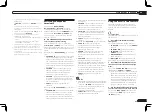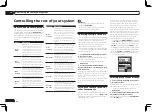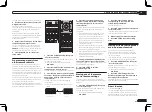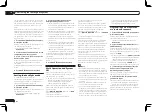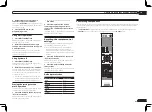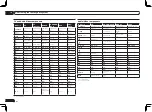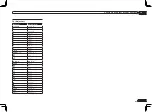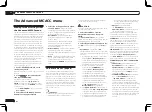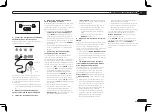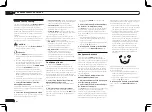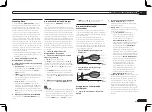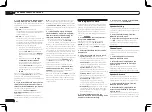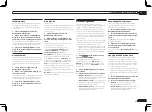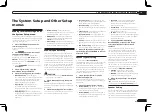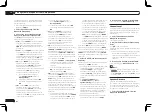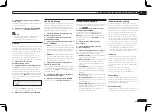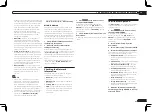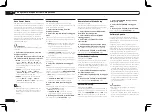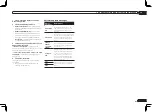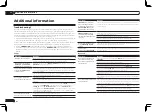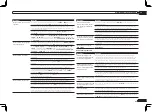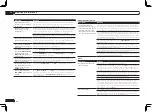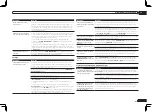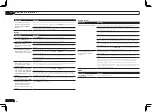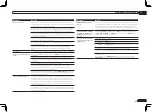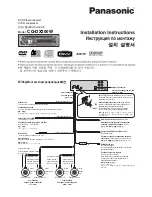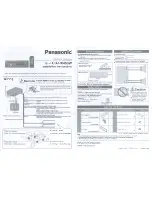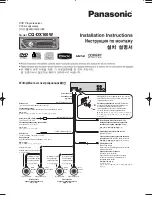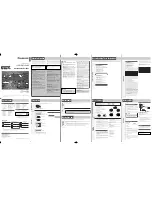
En
67
11
The Advanced MCACC menu
Standing Wave
Use this to display the standing wave related
adjustment values for the various MCACC
memories. See
Standing Wave
on page 65 for
1 Select ‘Standing Wave’ from the
MCACC Data Check menu.
2 When ‘Filter Channel’ is highlighted,
use
i
/
j
to select the channel for which
you want to check standing wave control.
The standing wave related calibration value
for the selected channel stored at the selected
MCACC preset and its graph are displayed.
3 Press
k
to highlight ‘MCACC’, then
use
i
/
j
to select the MCACC preset you
want to check.
Acoustic Cal EQ
Use this to display the calibration values for the
frequency response of the various channels set
in the different MCACC presets. See
Acoustic
Calibration EQ Adjust
on page 65 for more on
this.
1 Select ‘Acoustic Cal EQ’ from the
MCACC Data Check menu.
2 When ‘Ch’ is highlighted, use
i
/
j
to
select the channel.
The calibration value for the frequency response
of the selected channel stored at the selected
MCACC preset and its graph are displayed.
3 Press
k
to highlight ‘MCACC’, then
use
i
/
j
to select the MCACC preset you
want to check.
Group Delay
VSX-1326 only
Use this to display the calibrated speaker group
delay results. See
Better sound using Phase
Control and Full Band Phase Control
on page 39
for more on this.
1 Select ‘Group Delay’ from the
MCACC Data Check menu.
2 When ‘Channel’ is highlighted, use
k
/
l
to select the channel you want to
check.
The result of group delay calibration for the
selected channel is displayed.
When measurements have been per-
formed with
Full Auto MCACC
selected
at
Advanced MCACC
or with
ALL
or
Full Band Phase Ctrl
selected when
Auto MCACC
is selected, the graph before
group delay calibration is also displayed.
When
After
is selected at
Calibration
, the
group delay after calibration is displayed.
Compared to when
Before
is selected, with
After
there is less difference in the delay
between frequency bands and the group delay
between the different channels is uniform,
allowing you to check the full band phase con-
trol effect.
No Data
is displayed if the selected group delay
has not been measured.
Data Management
This system allows you to store up to six
MCACC presets, allowing you to calibrate your
system for different listening positions (or
frequency adjustments for the same listening
position). This is useful for alternate settings
to match the kind of source you’re listening to
and where you’re sitting (for example, watching
movies from a sofa, or playing a video game
close to the TV).
From this menu you can copy from one preset
to another, name presets for easier identifica-
tion and clear any ones you don’t need.
!
This can be done in
Automatically conducting
optimum sound tuning (Full Auto MCACC)
on
page 26 or
Automatic MCACC (Expert)
on page
62 , either of which you should have already
completed.
1 Press
on the remote control,
then press HOME MENU.
A Graphical User Interface (GUI) screen
appears on your TV. Use
i
/
j
/
k
/
l
and
ENTER
to navigate through the screens and
select menu items. Press
RETURN
to exit the
current menu.
2 Select ‘Data Management’ from the
Home Menu.
3 Select the setting you want to adjust.
!
Memory Rename
– Name your MCACC
presets for easy identification (see
Renaming
MCACC presets
on page 67 ).
!
MCACC Memory Copy
– Copy settings from
one MCACC preset to another (see
Copying
MCACC preset data
on page 67 ).
!
MCACC Memory Clear
– Clear any MCACC
presets that you don’t want (see
Clearing
MCACC presets
on page 68 ).
Renaming MCACC presets
If you have several different MCACC presets
that you’re using, you may want to rename
them for easier identification.
1 Select ‘Memory Rename’ from the
Data Management setup menu.
2 Select the MCACC preset you want to
rename, then select an appropriate preset
name.
Use
i
/
j
to select the preset, then
k
/
l
to
select a preset name.
3 Repeat for as many MCACC presets
as necessary, then press RETURN when
you’re finished.
You will return to the
Data Management
setup
menu.
Copying MCACC preset data
If you want to manually adjust the Acoustic
Calibration EQ (see
Manual MCACC setup
on
page 64 ), we recommend copying your current
settings to an unused MCACC preset. Instead
of just a flat EQ curve, this will give you a refer-
ence point from which to start.
!
The settings made in
Automatically conducting
optimum sound tuning (Full Auto MCACC)
on
page 26 or
Automatic MCACC (Expert)
on page
62 .
1 Select ‘MCACC Memory Copy’ from the
Data Management setup menu.
2 Select the setting you want to copy.
!
All Data
– Copies all the settings of the
selected MCACC preset memory.
!
Level & Distance
– Copies only the channel
level and speaker distance settings of the
selected MCACC preset memory.
Summary of Contents for VSX-1126-K
Page 100: ...100 13 Additional information En ...
Page 101: ...101 13 Additional information En ...
Page 102: ...102 13 Additional information En ...

